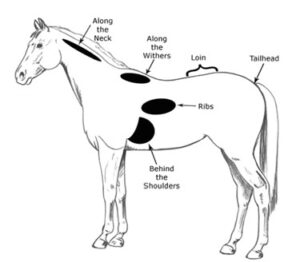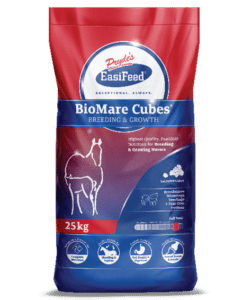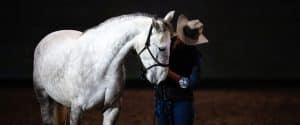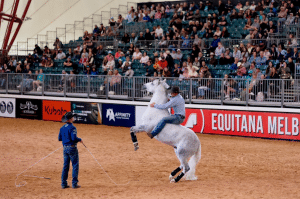Winter is a time of year many horse owner’s dread with limited daylight hours for riding, feeding horses in the dark and changing the management of our horses. It is also the time of year that we may see changes to our horses’ condition, usually a decrease in weight. This may be good for horses that hold their weight a little too well but can be stressful when our horses struggle to hold their weight normally or tend to drop off too much in winter. In this article the team at Pryde’s hope to give you some more information about how horses regulate their temperature, how pasture changes in winter and some feeding recommendations.
How cold is ‘cold’ to a horse?
A thermal comfort zone is the temperature range in which added energy is not required to regulate internal body temperature. For humans, this thermal comfort zone is around 25 degrees Celcius while in horses this ranges from 5 – 25 degrees Celcius in temperate environments. While this does depend on breed, age, health status and feed intake, it is fair to say that below and above these temperatures is when our horses begin expending energy to maintain their internal body temperature. This process of maintaining body temperature is known as thermoregulation. A thermoregulatory process that is most commonly seen in both humans and horses is shivering, where muscles rapidly contract to produce heat, energy stores are used to fuel this process. Those cold winter days and nights that drop below 5 degrees and our horses begin shivering, is often a contributing factor to horses losing weight over winter. However, many owners aim to minimise this by rugging their horses, which decreases the need to regulate their temperature on cold days and nights. Rugs are particularly effective when cold weather is combined with rain. As wet weather decreases your horse’s ability to use the thermoregulatory process known as piloerection, in which their hair ‘stands up’ and traps warm air close to their body and so they would have to shiver more to keep warm.
Tip: Use rugging effectively. If your horse is overweight, you may want to take advantage of the cooler weather and minimise rugging to assist weight loss. If your horse is underweight or struggles to maintain weight over winter, make use of warm rugs to minimise energy expenditure.
We all know Australia has some interesting weather and in some areas we can have quite warm winter days, make sure you rug appropriately. If we have a warm day do not leave a warm winter rug on, if horses get warmer than 25 degrees under their rug they begin having to expend energy to keep cool.
What happens to pasture over winter and how can this affect weight?
During winter in most areas of Australia, conditions for pasture growth are far from ideal and hence the amount of pasture available and the quality of it decreases; so forage intake may be limited. It is important to monitor both your horses’ pasture and body condition regularly. If your pasture quality and amount has visually decreased and your horses body condition has also decreased, when nothing else has changed this may be indicative that your horse is not obtaining enough forage.
Forage (or fibre) should form the basis of our horses’ diets. At a minimum a horse requires 1.5% of their body weight a day in forage, this equates to 7.5kg a day for a 500kg horse. If they are not obtaining this from their pasture it is important to add this in another form of forage such as hay or chaff. Enough fibre will not only help to maintain your horses’ weight but help to act as a natural heater.
Did you know that a product of fermentation (the process that occurs in the horses hindgut to digest fibre) is heat? This means that as your horses digestive system processes fibre it is also warming your horse up.
Tip: Consider feeding some extra hay of a night or on extra cold and rainy days to help your horse stay warm.
Here’s what to look for when body condition scoring your horse:
The Henneke System developed in 1983, is the common system used to condition score (assess the level of fat) on the horse.
Points of the horse assessed when body condition scoring
While the thermal comfort zone and fibre requirements of most horses is quite universal, the individual nutritional requirements of horses vary, particularly over winter so below are some feeding tips.
Feeding the overweight horse/the horse that gains weight in winter:
While winter can be a time to assist with weight loss and control it is important to still ensure their minimum forage, vitamin and mineral requirements are met. Consider feeding a grass hay that is lower in calories rather than a prime lucerne hay when added forage is required on top of pasture. Also consider removing grains, molasses, pellets and sweet feeds that are high in calories. Instead choose a lower calorie feed with low feeding rates. This minimises calorie intake, while ensuring vitamin and mineral requirements are met. For example, the 150 Essentials Pellet and EasiKeeper (suitable for laminitis) are low in digestible energy with a concentrated vitamin and mineral profile. So are ideal when <1kg of feed is required.

Feeding the underweight horse/the horse that loses weight in winter:
For owners with these horses, winter can be dreaded. If you know that your horse tends to lose weight in winter take advantage of Summer and Autumn to put on some extra weight. This way they will have some added fat which can assist with insulation and they will have extra calories to burn when the weather turns cold. Ensure their forage requirements are met or exceeded (the more forage in the diet the better) with good quality fibre sources including lucerne, oaten and grass hay and lupin hulls or sugar beet pulp. Consider adding in a feed that is higher in calories. This may look like a feed that contains extruded grains for improved digestion, pellets and adding oil. You can also look for a feed with higher feeding rates. For example, both the BioMare Cubes and OldTimer are full feeds with added vitamins and minerals that contain extruded grain and are higher in calories to assist in gaining weight.
Feeding a horse that struggles to maintain their weight in winter but either can’t handle grain when they are ridden or can’t have grain because of metabolic issues such as laminitis or cushing’s:
This can seem like a difficult scenario, but with correct nutrition these conditions can be managed. Firstly, as with the above two scenarios ensure plenty of fibre. Lucerne, teff, rhodes grass or native grass hays are good low sugar options and for horses with metabolic issues and limit grazing to early hours of the morning. When selecting a feed for added calories look for feeds that are grain and grain by product free. For example, EasiSport is a completely grain free full feed with added vitamins and minerals, which can then be topped up EasiFibre or LupinPak for added calories for weight gain or energy; without added starch or sugar. Adding in an oil such as EasiOil is also a great option for weight gain and cool energy for performance.
In Summary:
✔️ Rug your horse effectively
✔️ Feed plenty of fibre
✔️ Check your horses body condition regularly
✔️ Ensure vitamin and mineral requirements are met
✔️ Feed according to your horses’ requirements
If you are unsure of a feed that would be suitable for your horse you can use the free feed selector on the Pryde’s website or you can get in touch.
Learn more about the Feed Selector Here












